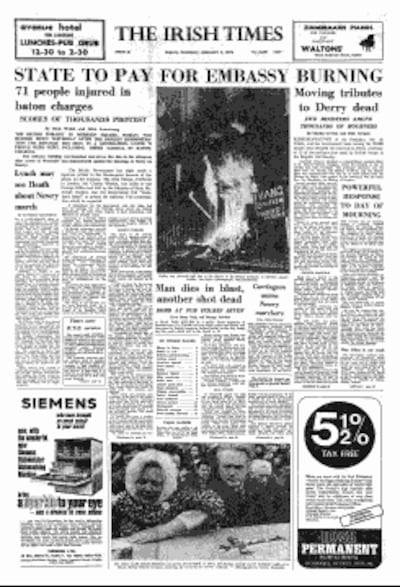Wednesday, February 2nd, 1972, was supposed to have been a day of mourning in the Republic for the victims of Bloody Sunday. It turned into a day of rage.
The British embassy, then located at No 39 Merrion Square in Dublin, had been the focal point of public anger over the killing of 13 people on a protest march in Derry three days previously. A 14th person died later.
Gardaí fended off previous attempts to burn the embassy, following official and Provisional IRA exhortations to “burn the bastards out”, by baton-charging protesters.
On the night of February 1st petrol bombs were thrown at the door of the embassy. The fires were put out but a gelignite bomb was then thrown, blowing the door in. No tradesman could be found to replace the door. It was boarded up.
On February 2nd gardaí considered calling in the army, but it was decided that such a display of strength would do nothing to calm the crowd, according to Brian Hanley in his book Boiling Volcano: The Impact of the Troubles on the Republic of Ireland, 1968-79.
Thousands took to the streets across the Republic on February 2nd despite wind and rain, but the largest crowd gathered outside the British embassy.
They had come from a protest in Parnell Square. Thirteen black coffins were carried at the head of the protest, one for each of the victims of Bloody Sunday.
Among the crowd that day was Paul Shannon, his wife and young daughter. Mr Shannon had been a member of Fianna Éireann, the republican boy scouts, at the time. A firefighter by trade, that evening he left Tara Street in a tender to put the fire out.
“The protesters were all outside at the front throwing stones and the boys from the local IRA were there. I put my head around and said, ‘what’s the problem? We were told they were going to make another attack on the front of it and didn’t want any firemen injured’,” he said.

Three young men climbed on to the balcony of the embassy. One ran a Tricolour up the flagpole outside the embassy and the other smashed the bulletproof window with a hatchet.
When that was achieved, another man doused the upstairs room with petrol and set fire to it with a match borrowed from the crowd who cheered every move. This was the queue for others to throw petrol bombs at the embassy.
"The bombs had been especially designed by students in the Kevin Street Technical College. They were made up of a small amount of petrol and sugar. I'm presuming it was Dublin brigade members of the IRA," Mr Shannon said. The Irish Times reported a "fusillade of fire bombs" were thrown at the building.
Two fire tenders and an ambulance were on site, but they could not access the building from the front because of the crowds.
It was difficult for firefighters to put out the fire because they could not get near the front of the embassy. They would most likely have been attacked.
“By the stage the boys got near it, it was burned down. We only gave it a washdown. It was a shell. You couldn’t get the angle to get into it. We weren’t prepared for all this thing,” he said.
“People were very angry. If you ask my opinion, the gardaí and the government allowed the people to burn the embassy to get rid of the anger. You could count on two hands the number of gardaí that were there. Nobody lost their lives, not like the Stardust [fire].”
Mr Shannon said there were two buildings either side of the embassy that they had to save. He put his own personal feelings aside at the time to do his job.
“Whether we agreed with the burning or not, our job was to save lives and put out the fire. You don’t consider anybody’s politics when it comes to firefighting. Your job is to save lives and make buildings safe.”
The Irish Times described the scenes outside Merrion Square as the “biggest demonstration the Republic has seen in a generation”.
Seventy-one people including three gardaí were injured during baton charges.
Demonstrators also attacked the British passport office with petrol bombs leading to a baton charge by gardaí.
Among those injured was The Irish Times photographer Jack McManus, who was hit on the head by a baton and recalled at the time: “One of the petrol bombs landed among the gardaí and they immediately drew their batons and charged. It was extremely violent. Demonstrators appeared to be throwing petrol bombs at the gardaí who scattered into the surrounding streets after them.”











